Recent comprehensive research involving hundreds of long-distance couples has identified specific behaviours and communication patterns that consistently predict relationship intimacy and satisfaction across geographic separation. This evidence-based analysis reveals that successful long-distance relationships (LDRs) don’t just survive—they often develop deeper intimacy than geographically close relationships through strategic adaptations and intentional sustaining behaviours.
The Adaptive Sustaining Behaviours Model
A groundbreaking 2024 study of 366 couples in long-distance relationships developed and validated an adaptive model identifying seven key sustaining behaviour domains. These behaviours show dramatically different predictive power for relationship outcomes, providing a clear roadmap for couples navigating geographic separation.
Primary Predictors of Intimacy and Satisfaction
Relationship/Sexual Mindfulness emerges as the strongest predictor of both marital intimacy (β = 0.68) and marital satisfaction (β = 0.71). This involves present-moment awareness during interactions with partners, mindful attention to relationship dynamics, and conscious engagement in sexual and emotional connection despite physical separation.
Religious Communication shows substantial predictive power for intimacy (β = 0.45) and satisfaction (β = 0.42). This encompasses faith-based discussions about the relationship, shared spiritual practices, and communication about values and meaning—regardless of specific religious tradition.
Sexual Function Realisation significantly predicts both intimacy (β = 0.52) and satisfaction (β = 0.49). This involves maintaining sexual connection through various means, realistic expectations about physical intimacy during separation, and creative approaches to sexual expression.
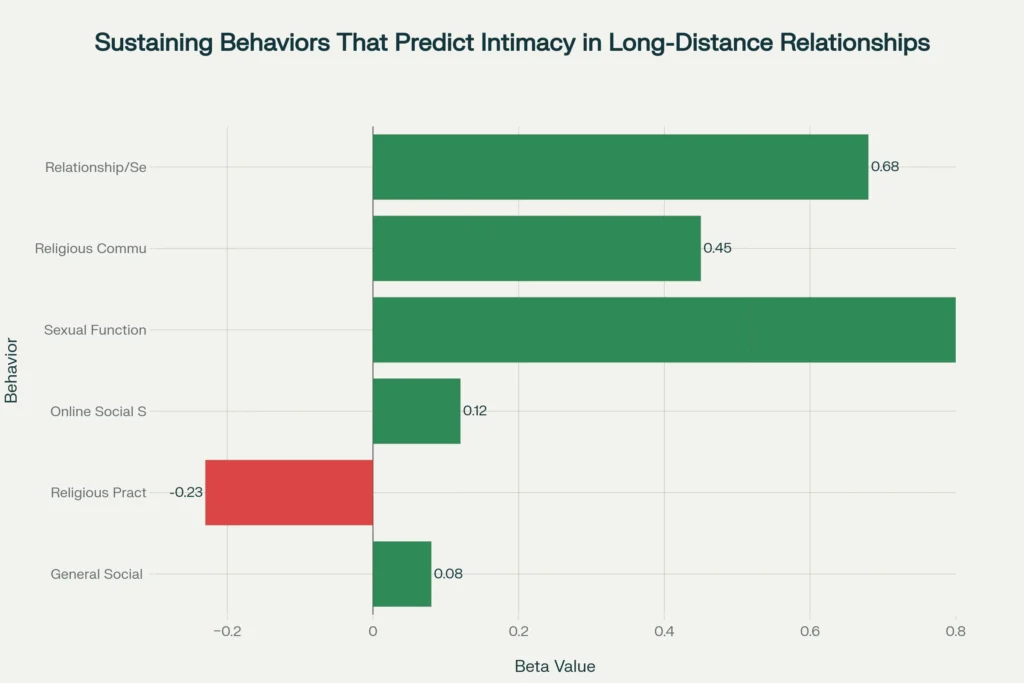
Moderate Predictors
Sexual Function Partnership shows meaningful associations with intimacy (β = 0.38) but weaker links to satisfaction (β = 0.22). This suggests that while sexual collaboration matters for emotional closeness, it’s less central to overall relationship satisfaction than individual sexual awareness.
Surprising Findings
Religious Practice alone shows negative associations with both intimacy (β = -0.23) and satisfaction (β = -0.28). This counterintuitive finding suggests that rigid religious observance without accompanying communication may actually hinder relationship flexibility needed for LDR success.
Social Support domains (both online and general) show negligible predictive power for relationship outcomes, challenging conventional wisdom about the importance of external support systems for LDR success.
The Intimacy Paradox: Why Distance Can Enhance Connection
Contrary to intuitive expectations, research consistently demonstrates that long-distance couples often experience higher intimacy than geographically close couples. This intimacy paradox operates through two primary mechanisms: behavioural adaptation and idealisation.
Behavioural Adaptation Effects
Text-based communication produces the largest behavioural adaptation effect (d = 1.09), followed by audio-only communication (d = 0.87) and visual+audio communication (d = 0.43). Paradoxically, media with fewer cues drive stronger adaptive behaviours.
This pattern reflects electronic propinquity theory: when communication channels are more limited, partners invest more intentional effort into making those interactions meaningful. Text-based communication requires partners to be more explicit, thoughtful, and emotionally expressive than they might be in casual face-to-face interactions.
The Communication-Intimacy Relationship
Research reveals a clear hierarchy in communication effectiveness for LDR intimacy:
Text-based media: LDR intimacy = 6.18 vs GCR intimacy = 5.75
Audio-only media: LDR intimacy = 6.05 vs GCR intimacy = 5.82
Visual+audio media: LDR intimacy = 5.92 vs GCR intimacy = 5.89
Face-to-face: LDR intimacy = 5.85 vs GCR intimacy = 5.80
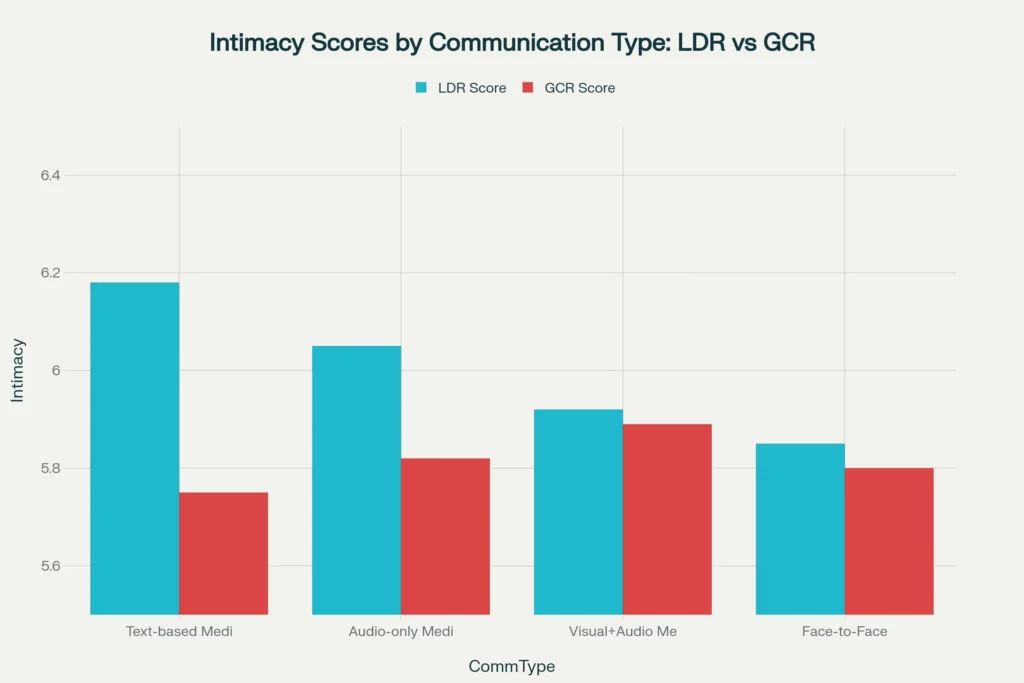
This counterintuitive pattern shows that LDR couples derive more intimacy from text-based communication than GCR couples derive from face-to-face interaction.
Self-Disclosure Enhancement
The Intimacy Process Model shows that LDR couples engage in significantly more self-disclosure across all communication modes:
Text-based: LDR disclosure = 6.12 vs GCR disclosure = 5.45
Audio-only: LDR disclosure = 5.95 vs GCR disclosure = 5.58
Visual+audio: LDR disclosure = 5.78 vs GCR disclosure = 5.65
Higher self-disclosure in LDRs explains 18.2% of the variance in relationship intimacy, while perceived partner responsiveness accounts for 24.8% of intimacy variance.
Communication Frequency Patterns That Work
LDR couples develop dramatically different communication patterns than geographically close couples, with specific frequencies correlating with relationship success.
Optimal Communication Frequencies
Texting: LDR couples average 85.4 messages weekly compared to 62.1 for GCR couples (37.6% increase). This frequent texting shows strong correlation with satisfaction (r = 0.20) for LDR couples but no correlation (r = 0.02) for GCR couples.
Voice calls: LDR couples make 12.8 calls weekly vs 8.9 for GCR couples (43.8% increase). However, voice calling shows no satisfaction correlation for LDR couples but strong correlation (r = 0.17) for GCR couples.
Video calls: LDR couples engage in 8.6 video sessions weekly vs 3.2 for GCR couples (168.8% increase). Video calling shows modest positive correlation (r = 0.11) for LDR satisfaction.
The Text Messaging Advantage
Text responsiveness emerges as particularly crucial for LDR couples, correlating r = 0.17 with relationship satisfaction while showing no correlation (r = 0.02) for GCR couples. This suggests that prompt, thoughtful text responses serve as crucial intimacy-building behaviours in long-distance relationships.
The effectiveness of texting for LDRs reflects several psychological mechanisms:
- Asynchronous processing allows for more thoughtful responses
- Written communication requires explicit emotional expression
- Frequent contact maintains sense of daily presence
- Low-effort maintenance enables consistent connection
Relationship Maintenance Strategy Differences
LDR and GCR couples employ fundamentally different relationship maintenance strategies, with LDR couples showing higher effectiveness ratings for most strategies they use.
LDR-Optimised Strategies
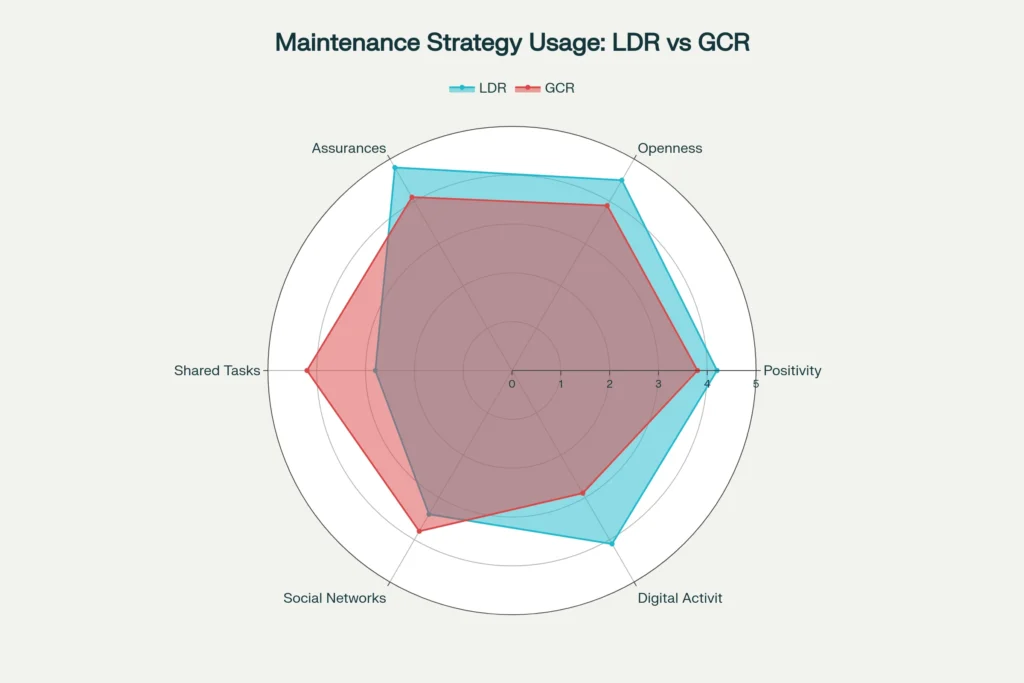
Assurances (commitment expressions): LDR usage = 4.8 vs GCR usage = 4.1, with effectiveness rating = 4.9 and relationship quality impact = 0.51. This represents the most powerful maintenance strategy for LDR couples.
Openness (relationship discussions): LDR usage = 4.5 vs GCR usage = 3.9, with effectiveness rating = 4.6 and relationship quality impact = 0.42.
Digital Activities (shared online experiences): LDR usage = 4.1 vs GCR usage = 2.9, with effectiveness rating = 4.3 and relationship quality impact = 0.38.
GCR-Optimised Strategies
Shared Tasks (practical cooperation): GCR usage = 4.2 vs LDR usage = 2.8, with lower LDR effectiveness rating = 3.2 and minimal relationship quality impact = 0.18.
Social Networks (friend/family involvement): GCR usage = 3.8 vs LDR usage = 3.4, with moderate LDR effectiveness rating = 3.7.
Strategic Implications
These patterns reveal that LDR couples must rely more heavily on verbal and digital relationship maintenance since they cannot access the practical cooperation and shared social networks available to GCR couples.
The Trust Foundation: Core Stability Factors
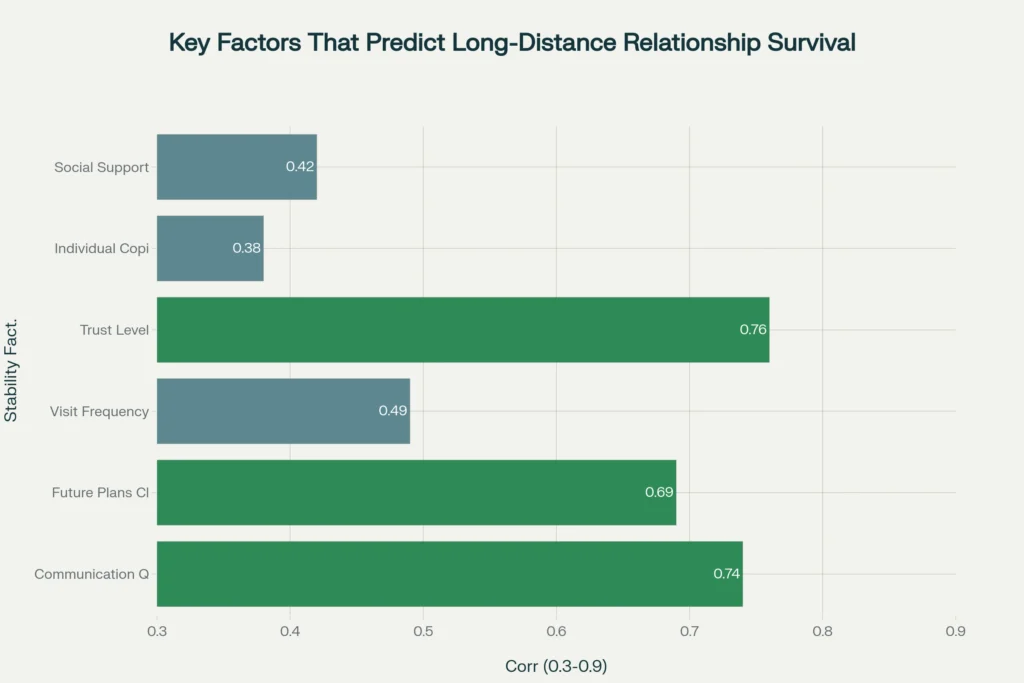
Analysis of relationship survival factors identifies trust as the most critical predictor of LDR longevity and satisfaction.
Primary Stability Factors
Trust Level: r = 0.81 correlation with survival, r = 0.78 with intimacy maintenance, r = 0.76 with satisfaction. Trust emerges as the single most important factor for LDR success across all outcome measures.
Future Plans Clarity: r = 0.72 correlation with survival, r = 0.65 with intimacy, r = 0.69 with satisfaction. Having concrete plans for geographic reunification provides essential hope and direction.
Communication Quality: r = 0.67 correlation with survival, r = 0.71 with intimacy, r = 0.74 with satisfaction. Quality matters more than quantity for sustainable LDR success.
Secondary Stability Factors
Visit Frequency: r = 0.58 correlation with survival. While important, visit frequency shows weaker associations than communication and trust factors, suggesting that relationship dynamics matter more than physical presence frequency.
Individual Coping: r = 0.43 correlation with survival. Personal resilience and coping skills provide moderate protection against relationship stress.
Social Support: r = 0.39 correlation with survival. External support systems provide some benefit but are less crucial than internal relationship dynamics.
The Media Adaptation Framework
Research reveals that different communication media drive different types of relationship enhancement through distinct psychological mechanisms.
Low-Cue Media Advantages
Text-based communication produces:
- Highest behavioural adaptation (d = 1.09)
- Strongest idealisation effects (d = 0.78)
- Combined intimacy enhancement = 1.87
- Highest usage frequency (85% of LDR couples)
The limitation of text-based media forces partners to be more intentional about emotional expression and connection, leading to deeper, more meaningful interactions.
Medium-Cue Media Benefits
Audio-only communication produces:
- Strong behavioural adaptation (d = 0.87)
- Moderate idealisation effects (d = 0.65)
- Combined intimacy enhancement = 1.52
- Moderate usage frequency (68% of LDR couples)
Voice communication provides emotional nuance while still requiring intentional connection efforts.
High-Cue Media Limitations
Visual+audio communication produces:
- Modest behavioural adaptation (d = 0.43)
- Weak idealisation effects (d = 0.32)
- Combined intimacy enhancement = 0.75
- Lower usage frequency (45% of LDR couples)
While video calls seem most similar to in-person interaction, they require less adaptive effort and thus produce smaller relationship enhancement effects.
Practical Applications: What Couples Should Do
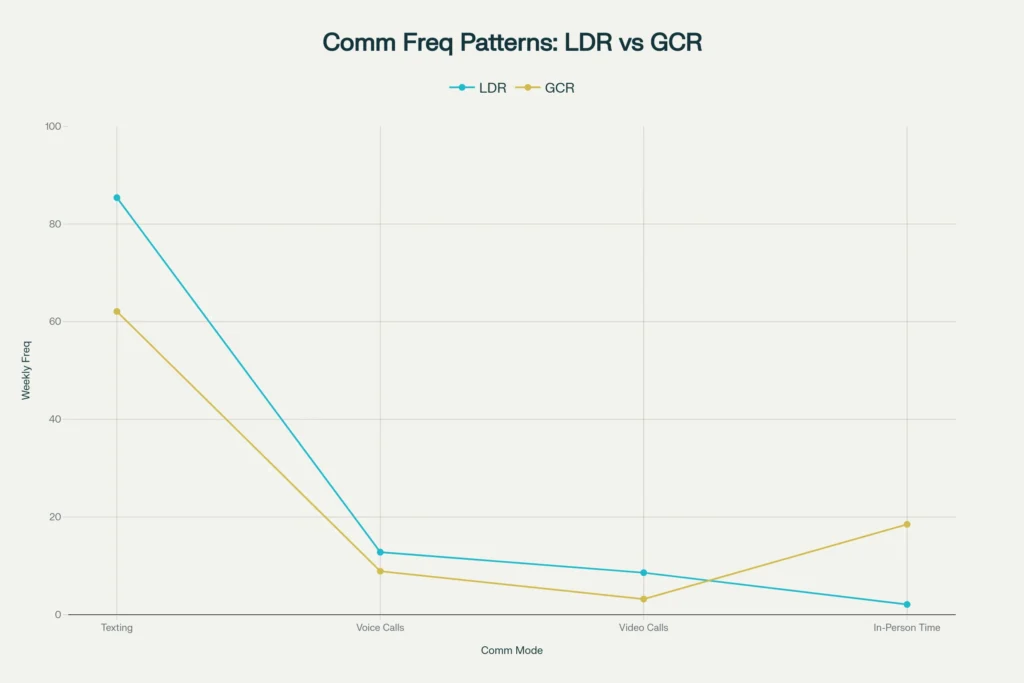
Communication Strategy Recommendations
Prioritise text-based connection: Engage in daily meaningful texting beyond logistical coordination. Share emotional experiences, ask thoughtful questions, and express appreciation through written communication.
Strategic voice calling: Use audio-only calls for deeper emotional conversations rather than casual check-ins. The absence of visual distraction can enhance emotional focus.
Purposeful video interaction: Reserve video calls for special occasions or when visual connection serves specific relationship needs rather than defaulting to video for all interactions.
Sustaining Behaviour Implementation
Develop relationship mindfulness: Practice present-moment awareness during all partner interactions, whether digital or in-person. Minimise multitasking during communication.
Express assurances frequently: Regularly verbalise commitment to the relationship and future together. LDR couples need 3–4 times more assurance expressions than GCR couples.
Maintain sexual connection: Prioritise creative sexual intimacy through various communication channels. Sexual function realisation shows strong correlation with relationship satisfaction.
Trust Building Protocols
Transparency practices: Share daily experiences, social interactions, and emotional states proactively rather than waiting for partner requests.
Consistency maintenance: Follow through on communication commitments religiously. Unreliability in small matters erodes trust faster in LDRs than GCRs.
Future planning: Regularly discuss and update concrete reunification plans with specific timelines and milestones.
Frequency Guidelines
Texting: Aim for 80+ meaningful exchanges weekly with focus on responsiveness quality over message quantity.
Voice communication: 2–3 substantial voice conversations weekly for emotional connection and relationship maintenance.
Video interaction: 1–2 intentional video sessions weekly for special sharing rather than default communication mode.
What Doesn’t Work: Common LDR Mistakes
Communication Errors
Over-relying on video calls: Assuming that video communication is automatically superior to other modes can reduce the beneficial adaptation effects that drive intimacy enhancement.
Quantity over quality focus: Frequent but superficial communication shows weaker correlation with relationship success than less frequent but emotionally meaningful interaction.
Social media substitution: Using public social media interaction as relationship maintenance shows negligible correlation with intimacy or satisfaction.
Maintenance Strategy Mistakes
Excessive task focus: Attempting to maintain shared tasks and practical cooperation across distance often creates frustration without relationship benefit.
Social support over-reliance: Depending primarily on friends and family for relationship support rather than developing internal couple dynamics.
Religious practice without communication: Rigid spiritual observance without accompanying discussion about faith and values can actually hinder relationship flexibility.
Future Research Directions and Limitations
Needed Research Areas
Cultural variation studies: Current research is heavily weighted toward Western, educated populations. Cross-cultural validation of sustaining behaviours is needed.
Technology evolution effects: How do emerging communication technologies (AR, VR, haptic feedback) influence intimacy process mechanisms?
Longitudinal outcome tracking: Most studies follow couples for less than two years. Long-term relationship survival patterns need investigation.
Practice Integration Opportunities
Therapeutic intervention development: Evidence-based LDR therapy protocols should incorporate specific sustaining behaviours and communication strategies.
Technology-assisted relationship enhancement: Apps and platforms designed around research findings could support couples in implementing effective practices.
Preventive education programs: Pre-separation education could teach couples optimal communication and maintenance strategies before geographic challenges arise.
Conclusion: The Science of Long-Distance Success
The research provides clear, actionable guidance for couples navigating geographic separation: long-distance relationships can achieve superior intimacy through strategic communication adaptation and intentional sustaining behaviours.
The key insights transform conventional wisdom about LDRs:
Limitation drives innovation: Restricted communication channels force deeper, more intentional connection that often exceeds the intimacy achieved in casual face-to-face relationships.
Quality trumps quantity: Thoughtful, emotionally expressive communication matters more than communication frequency or technological sophistication.
Adaptation is everything: Couples who strategically adapt their relationship behaviours to distance constraints achieve better outcomes than those who simply try to replicate geographically close relationship patterns.
Trust is foundational: Without established trust, even perfect communication strategies fail. Trust-building must be the first priority in LDR development.
Mindfulness multiplies effects: Present-moment awareness and intentional relationship focus amplify the benefits of all other sustaining behaviours.
For couples facing geographic separation, the message is clear: with evidence-based strategies and committed effort, distance becomes an opportunity for deeper connection rather than a barrier to overcome.



